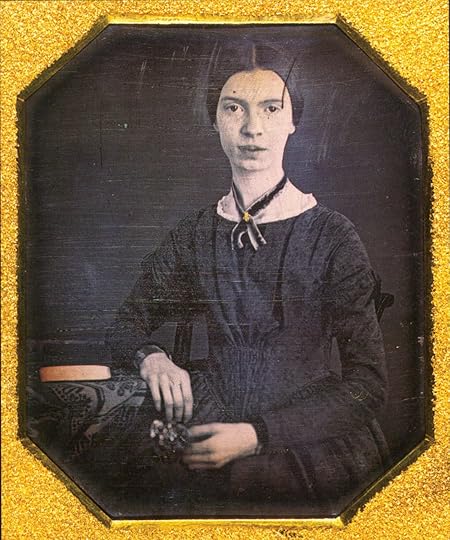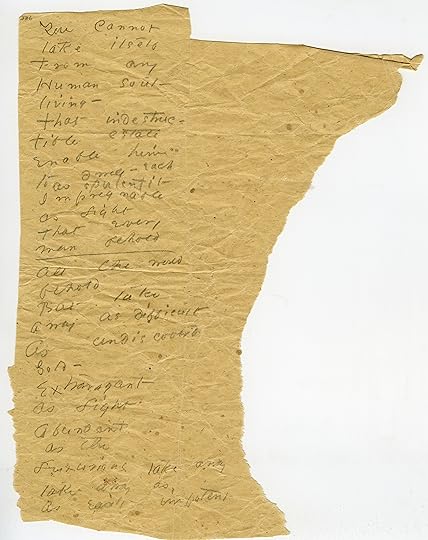Somewhere in an attic: the Emily Dickinson publishing dilemma
She’s been called “the myth of Amherst,” “the woman in white,” and a “recluse,” but the truth about Emily Dickinson and her writings is still being revealed, 130 years after her death. It’s an intriguing story of love, betrayal, and unlikely collaborations, and one that provokes several questions about the role that special collections and archives play in revealing important literary, historical, and biographical information to the public.
This story begins, rather oddly, at the end. Emily Dickinson’s death in 1886 marked the start of the generations-long debacle of publishing her wealth of poems. Emily’s sister, Lavinia Dickinson, was instructed to destroy Emily’s poems after her death, but decided to work on publishing them instead. She noticed Emily sent a large number of her poems—about 250—to her sister-in-law, Susan Dickinson, who was married to Emily and Lavinia’s brother, Austin Dickinson. Lavinia attempted to enlist Susan to help her in editing and publishing Emily’s poems. Susan shared no avid interest in the project, so Lavinia retrieved the poems and turned to an unexpected and controversial woman to aid her in this process: Mabel Loomis Todd, the woman with whom Austin Dickinson was having an extensive and very public affair. An even more salacious detail: Lavinia and Emily actually invited Mabel over to their home to meet Austin, some years prior, and Lavinia and Mable kept regular correspondence during her brother’s affair.
 Emily Dickinson daguerreotype. Photo “emilydickinsondaguerreotype-high-res” by Michael Medeiros/Emily Dickinson Museum. Used with permission.
Emily Dickinson daguerreotype. Photo “emilydickinsondaguerreotype-high-res” by Michael Medeiros/Emily Dickinson Museum. Used with permission.Todd, unlike Susan Dickinson, was a “new woman in the late 19th, early 20th century: an intellectual, a writer, well-traveled, active in society, and very capable of getting something like this done,” explains Michael Kelly, Head of the Archives and Special Collections department at the Amherst College Library in Amherst, Massachusetts. She was willing and able to take on this project, but there was just one problem: she was the mistress of Emily Dickinson’s brother and was therefore not well liked by Susan and Susan’s descendants.
In 1890, Lavinia Dickinson and Todd enlisted the assistance of Thomas Wentworth Higginson, a major literary critic and champion of women’s writing at the time, to edit a volume of Emily Dickinson’s poems still in Todd’s possession. Together between 1890 and 1891, they published two volumes of Dickinson’s poetry, Poems of Emily Dickinson (1890) and Poems of Emily Dickinson, Second Series (1891) both of which sold well. They intended to publish more of her work, but when Austin Dickinson died in 1895, their plan disintegrated, as a feud between the Dickinson and Todd families erupted.
Austin Dickinson, to reward Todd for her editorial work in publishing his late sister’s poems, left her a plot of land in his will. Susan and Lavinia wanted the land instead, and the two women sued Todd for it, claiming that her lack of upstanding character should deny her the right to the property. In her rage, Todd took the poems she still possessed and locked them away.
“For more than thirty years she refused to raise the lid of her camphorwood chest filled with the Dickinson poems in her possession,” explains Michael Medeiros, the Public Relations Coordinator at the Emily Dickinson Museum in Amherst, Massachusetts.
Eventually, the feud passed down to the younger generations of the Dickinson and Todd families, leaving Susan’s daughter Martha Dickinson Bianchi and Mabel’s daughter Millicent Todd Bingham to publish the remaining poems left in their respective collections. Martha donated her manuscripts to Harvard University in 1950, and Millicent relinquished hers to Amherst University in 1956, splitting the collection in two. A new exhibit at the Morgan Library and Museum in New York, running from 20 January 2017 until 21 May 2017 will showcase 100 rarely seen items, including manuscripts, letters, hand-cut silhouettes, photographs and daguerreotypes, and contemporary illustrations. Some of these items are entirely new to the public, suggesting that there may be more poems still to uncover, somewhere…
 Photo of an Emily Dickinson poem, original manuscript. Photo “You cannot take itself” by Amherst College Digital Collections, courtesy of Michael Kelly. Used with permission.
Photo of an Emily Dickinson poem, original manuscript. Photo “You cannot take itself” by Amherst College Digital Collections, courtesy of Michael Kelly. Used with permission.“You don’t know what’s still sitting in somebody’s attic in New England,” says Michael Kelly. “The exhibit at Morgan will include things no one knew existed 10 years ago, and we are completely open to the fact that someone might turn up more Dickinson material, someday.”
The story keeps evolving, and Kelly stresses the important role of the Special Collections and Archive departments within libraries to continue to update and retell it. “Archives have to keep telling history over and over and over,” he remarks. “The more I get into it, the more fascinating it is.”
This story raises many questions for me, an insatiable reader and lover of literature, regarding the ethics of retaining literary content from the public eye, while also maintaining the right of the author or owner to keep possessions private. How could Mabel keep those poems for 30 years, locked away, unable to be read? Was she denying the public access to an entire literary collection, or simply exercising her right to keep her private property private? I spoke to Cynthia Harbeson, Head of Special Collections at The Jones Library in Amherst, Massachusetts about this dilemma from a librarian’s perspective.
“It’s not necessarily the role of the librarian to determine what materials survive,” Harbeson informs me, “but we do have a role in protecting and making available the materials in our care–and in advocating for records of cultural and historical value to be preserved. And what is considered to be of value changes over time.”
Technically, the Todd and Dickinson families had every legal right to keep Emily’s poems to themselves, forever. Thankfully, the families went in the other direction, but I still wonder: what if the Todd and Dickinson families never published Emily’s poetry, or if they destroyed all of it?
“Emily Dickinson actually wanted all her manuscripts destroyed after her death,” Kelly explains. “So many things survive only by chance—it’s madness, and that’s kind of the thing about it. We need to be defenders of people’s actual rights—they (the family members) had the right to keep them locked away forever.”
Despite Mabel Loomis Todd’s character and the Dickinson family’s sometimes questionable behavior, one could argue that the Dickinson and Todd families did the world of literature a great service by editing and publishing Emily Dickinson’s poems. Who knows, maybe there are still more out there, somewhere in an attic, waiting to be uncovered—or so I like to think.
Featured image credit: “emilycalendar45” photo by Michael Medeiros/Emily Dickinson Museum. Used with permission.
The post Somewhere in an attic: the Emily Dickinson publishing dilemma appeared first on OUPblog.

Oxford University Press's Blog
- Oxford University Press's profile
- 238 followers



